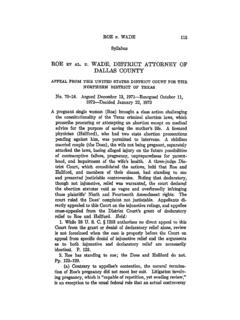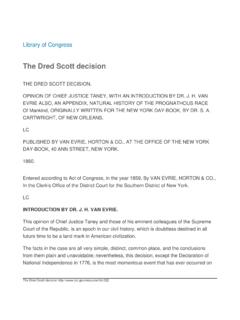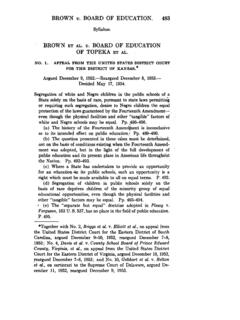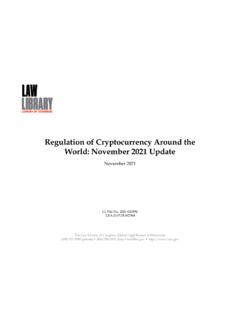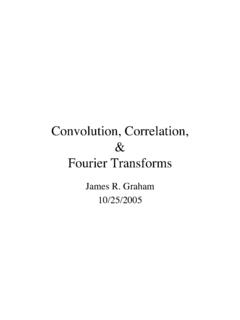Transcription of GRAHAM v. CONNOR ET AL. - Library of Congress
1 OCTOBER TERM, 1988 Syllabus 490 U. v. CONNOR ET TO THE UNITED STATES COURT OF APPEALS FORTHE FOURTH CIRCUITNo. 87-6571. Argued February 21, 1989-Decided May 15, 1989 Petitioner GRAHAM , a diabetic, asked his friend, Berry, to drive him to aconvenience store to purchase orange juice to counteract the onset of aninsulin reaction. Upon entering the store and seeing the number of peo-ple ahead of him, GRAHAM hurried out and asked Berry to drive him to afriend's house instead. Respondent CONNOR , a city police officer, be-came suspicious after seeing GRAHAM hastily enter and leave the store,followed Berry's car, and made an investigative stop, ordering the pairto wait while he found out what had happened in the store. Respondentbackup police officers arrived on the scene, handcuffed GRAHAM , andignored or rebuffed attempts to explain and treat GRAHAM 's the encounter, GRAHAM sustained multiple injuries.
2 He was re-leased when CONNOR learned that nothing had happened in the filed suit in the District Court under 42 U. S. C. 1983 againstrespondents, alleging that they had used excessive force in making thestop, in violation of "rights secured to him under the Fourteenth Amend-ment to the United States Constitution and 42 U. S. C. 1983." TheDistrict Court granted respondents' motion for a directed verdict at theclose of GRAHAM 's evidence, applying a four-factor test for determiningwhen excessive use of force gives rise to a 1983 cause of action, whichinquires, inter alia, whether the force was applied in a good-faith effortto maintain and restore discipline or maliciously and sadistically for thevery purpose of causing harm. Johnson v. Glick, 481 F. 2d 1028. TheCourt of Appeals affirmed, endorsing this test as generally applicable toall claims of constitutionally excessive force brought against governmentofficials, rejecting GRAHAM 's argument that it was error to require him toprove that the allegedly excessive force was applied maliciously and sa-distically to cause harm, and holding that a reasonable jury applying theJohnson v.
3 Glick test to his evidence could not find that the force appliedwas constitutionally : All claims that law enforcement officials have used excessive force-deadly or not-in the course of an arrest, investigatory stop, or other"seizure" of a free citizen are properly analyzed under the FourthAmendment's "objective reasonableness" standard, rather than under asubstantive due process standard. Pp. v. CONNOR386 Syllabus(a) The notion that all excessive force claims brought under 1983 aregoverned by a single generic standard is rejected. Instead, courts mustidentify the specific constitutional right allegedly infringed by the chal-lenged application of force and then judge the claim by reference to thespecific constitutional standard which governs that right. Pp. 393-394.(b) Claims that law enforcement officials have used excessive force inthe course of an arrest, investigatory stop, or other "seizure" of a freecitizen are most properly characterized as invoking the protections of theFourth Amendment, which guarantees citizens the right "to be secure intheir persons.
4 Against unreasonable seizures," and must be judgedby reference to the Fourth Amendment's "reasonableness" 394-395.(c) The Fourth Amendment "reasonableness" inquiry is whether theofficers' actions are "objectively reasonable" in light of the facts andcircumstances confronting them, without regard to their underlying in-tent or motivation. The "reasonableness" of a particular use of forcemust be judged from the perspective of a reasonable officer on the scene,and its calculus must embody an allowance for the fact that police officersare often forced to make split-second decisions about the amount of forcenecessary in a particular situation. Pp. 396-397.(d) The Johnson v. Glick test applied by the courts below is incompat-ible with a proper Fourth Amendment analysis. The suggestion thatthe test's "malicious and sadistic" inquiry is merely another way of de-scribing conduct that is objectively unreasonable under the circum-stances is rejected.
5 Also rejected is the conclusion that because individ-ual officers' subjective motivations are of central importance in decidingwhether force used against a convicted prisoner violates the EighthAmendment, it cannot be reversible error to inquire into them in decid-ing whether force used against a suspect or arrestee violates the FourthAmendment. The Eighth Amendment terms "cruel" and "punish-ments" clearly suggest some inquiry into subjective state of mind,whereas the Fourth Amendment term "unreasonable" does not. More-over, the less protective Eighth Amendment standard applies only afterthe State has complied with the constitutional guarantees traditionallyassociated with criminal prosecutions. Pp. F. 2d 945, vacated and , C. J., delivered the opinion of the Court, in which WHITE,STEVENS, O' CONNOR , SCALIA, and KENNEDY, JJ., joined. BLACKMUN,J., filed an opinion concurring in part and concurring in the judgment, inwhich BRENNAN and MARSHALL, JJ.
6 , joined, post, p. TERM, 1988 Opinion of the Court 490 U. Gerald Beaver argued the cause for petitioner. On thebriefs was Richard B. I. Levy argued the cause for respondents. On thebrief was Frank B. Aycock III.*CHIEF JUSTICE REHNQUIST delivered the opinion of case requires us to decide what constitutional stand-ard governs a free citizen's claim that law enforcement offi-cials used excessive force in the course of making an arrest,investigatory stop, or other "seizure" of his person. We holdthat such claims are properly analyzed under the FourthAmendment's "objective reasonableness" standard, ratherthan under a substantive due process this action under 42 U. S. C. 1983, petitioner DethorneGraham seeks to recover damages for injuries allegedly sus-tained when law enforcement officers used physical forceagainst him during the course of an investigatory stop.
7 Be-cause the case comes to us from a decision of the Court ofAppeals affirming the entry of a directed verdict for respond-ents, we take the evidence hereafter noted in the light mostfavorable to petitioner. On November 12, 1984, GRAHAM , adiabetic, felt the onset of an insulin reaction. He asked afriend, William Berry, to drive him to a nearby conveniencestore so he could purchase some orange juice to counteractthe reaction. Berry agreed, but when GRAHAM entered thestore, he saw a number of people ahead of him in the check-*Briefs of amici curiae urging reversal were filed for the United Statesby Solicitor General Fried, Assistant Attorney General Reynolds, DeputyAssistant Attorney General Clegg, David L. Shapiro, Brian J. Martin,and David K. Flynn; and for the American Civil Liberties Union et al. bySteven R. H. Thornburg, Attorney General of North Carolina, Isaac III, Special Deputy Attorney General, and Linda Anne Morris, As-sistant Attorney General, filed a brief for the State of North Carolina asamicus curiae urging v.
8 CONNOR386 Opinion of the Courtout line. Concerned about the delay, he hurried out of thestore and asked Berry to drive him to a friend's CONNOR , an officer of the Charlotte, NorthCarolina, Police Department, saw GRAHAM hastily enter andleave the store. The officer became suspicious that some-thing was amiss and followed Berry's car. About one-halfmile from the store, he made an investigative stop. Al-though Berry told CONNOR that GRAHAM was simply sufferingfrom a "sugar reaction," the officer ordered Berry and Gra-ham to wait while he found out what, if anything, had hap-pened at the convenience store. When Officer CONNOR re-turned to his patrol car to call for backup assistance, Grahamgot out of the car, ran around it twice, and finally sat down onthe curb, where he passed out the ensuing confusion, a number of other Charlotte po-lice officers arrived on the scene in response to Officer Con-nor's request for backup.
9 One of the officers rolled Grahamover on the sidewalk and cuffed his hands tightly behind hisback, ignoring Berry's pleas to get him some sugar. An-other officer said: "I've seen a lot of people with sugar dia-betes that never acted like this. Ain't nothing wrong withthe M. F. but drunk. Lock the S. B. up." App. 42. Sev-eral officers then lifted GRAHAM up from behind, carried himover to Berry's car, and placed him face down on its consciousness, GRAHAM asked the officers to checkin his wallet for a diabetic decal that he carried. In re-sponse, one of the officers told him to "shut up" and shovedhis face down against the hood of the car. Four officersgrabbed GRAHAM and threw him headfirst into the police friend of GRAHAM 's brought some orange juice to the car,but the officers refused to let him have it. Finally, OfficerConnor received a report that GRAHAM had done nothingwrong at the convenience store, and the officers drove himhome and released TERM, 1988 Opinion of the Court 490 U.
10 Some point during his encounter with the police, Gra-ham sustained a broken foot, cuts on his wrists, a bruisedforehead, and an injured shoulder; he also claims to havedeveloped a loud ringing in his right ear that continues to thisday. He commenced this action under 42 U. S. C. 1983against the individual officers involved in the incident, all ofwhom are respondents here,' alleging that they had usedexcessive force in making the investigatory stop, in violationof "rights secured to him under the Fourteenth Amendmentto the United States Constitution and 42 U. S. C. 1983."Complaint 10, App. The case was tried before a the close of petitioner's evidence, respondents moved fora directed verdict. In ruling on that motion, the DistrictCourt considered the following four factors, which it identi-fied as "[t]he factors to be considered in determining whenthe excessive use of force gives rise to a cause of action under 1983": (1) the need for the application of force; (2) therelationship between that need and the amount of force thatwas used; (3) the extent of the injury inflicted; and (4)"[w]hether the force was applied in a good faith effort tomaintain and restore discipline or maliciously and sadisticallyfor the very purpose of causing harm.
